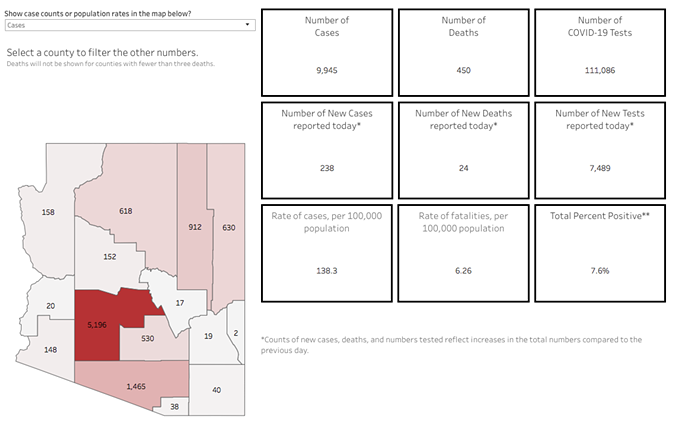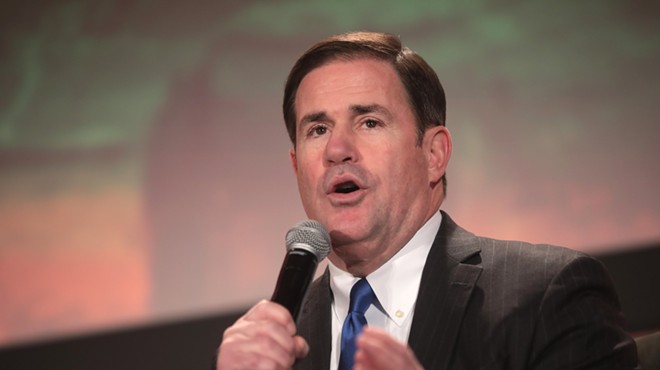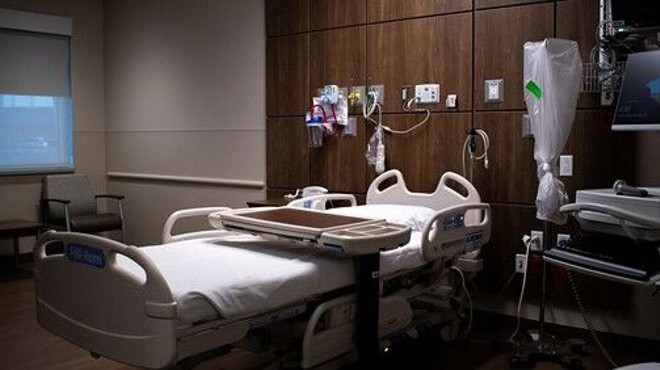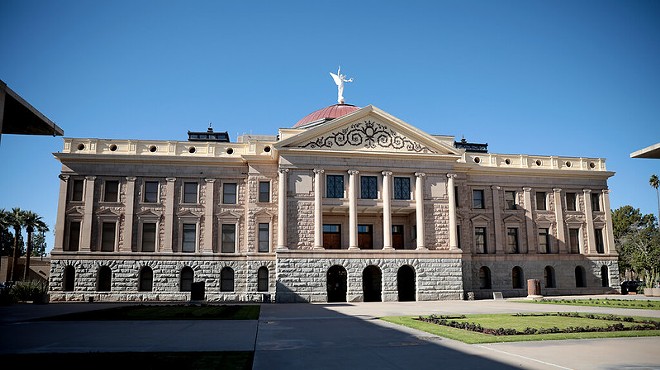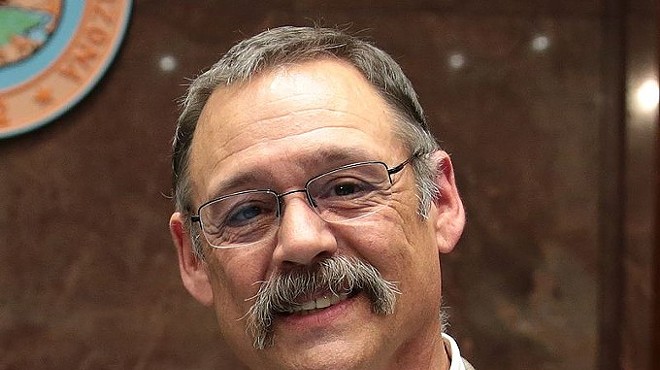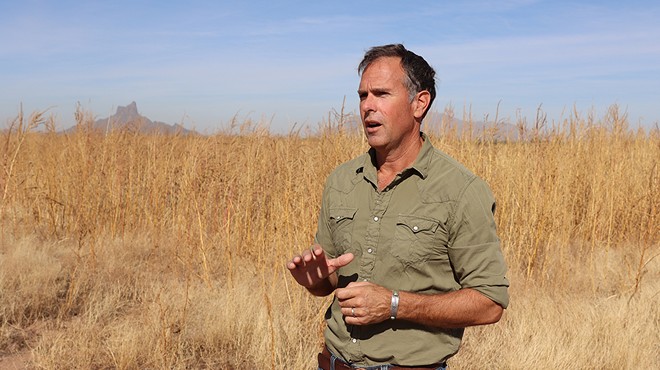Thursday, May 7, 2020
Your Southern AZ COVID-19 AM Roundup for Thursday, May 7: AZ Confirmed Cases Close in on 10K; 450 Now Dead; Ducey Admin Comes Under More Criticism For Telling Local Modeling Team To Cease Work
The number of confirmed coronavirus cases in Arizona closed in on the 10,000 mark as of Thursday, May 7, according to the morning report from the Arizona Department of Health Services.
Pima County had 1,465 of the state's 9,945 confirmed cases.
The coronavirus had killed 450 people statewide, including 118 in Pima County, according to the report.
In Maricopa County, the number of confirmed COVID-19 cases had risen to 5.196.
Although the state began a “testing blitz” over the weekend, Arizona lags other states in testing for COVID-19. Because symptoms can take as long as two weeks to appear after exposure to the virus (while some people can remain entirely asymptomatic), health officials continue to urge the public to avoid unnecessary trips and gatherings of more than 10 people and have advised people to cover their faces with masks in public.
Arizona remains under a stay-at-home order through May 15, but Gov. Doug Ducey has modified his emergency declaration. Stores can now reopen with curbside and delivery business. Customers will be able to browse inside stores and get haircuts beginning on Friday, while restaurants can begin serving customers next week. Ducey has set up various new regulations, including requirements to wear masks and a heightened cleaning regimen.
People are still advised to limit contact and many businesses must remain closed, but Ducey said he wanted the state’s economy to gradually reopen.
“These habits we've acquired over the last 45 days will not be with us forever, but they will be with us for the time being,” Ducey said.
But some members of the medical community said Ducey’s move may have come soon and will result in greater spread of the virus. Dr. Bob England, the outgoing director of the Pima County Health Department, warned yesterday that by relaxing so many standards so quickly, Ducey was risking losing all the progress that state has made in stemming the disease, but the true results wouldn’t be known for weeks as test results tend to lag behind the actual spread of the virus.
“It will take a few weeks to know the impact of this so we won’t know until early June what all of this is doing to the epidemic curve,” England said in a daily briefing.
England urged people to continue social distancing and wear masks and said older people and those with underlying health conditions should remain at home as much as possible.
The Ducey administration came under criticism this week for telling university professors who had been modeling COVID-19’s spread to cease work.
Ducey spokesman Patrick Ptak said that the state had decided to go with a model that had been developed by the Federal Emergency Management Agency and the Centers for Disease Control and Prevention.
“When we first started tracking data, the state utilized various models to help predict future outcomes and make decisions in real-time,” Ptak said. “Their projections were often widely divergent and constantly changing. … We now have two months of on-the-ground data. We’ve been able to see which models are accurate—which match the actual facts and are most useful—and which are not. Dr. Cara Christ, the director of the Arizona Department of Health Services, is an infectious disease epidemiologist and public health expert. She made the decision after reviewing all the data. The modeling we are utilizing going forward is developed by FEMA and CDC and ensures our hospitals have capacity for any situation. That is the case currently, but we aren’t taking any chances.”
But Will Humble, the former director of the Arizona Department of Health, criticized the decision to shut down the local modeling effort in a Wednesday blog entry on the Arizona Public Health Association website.
“Astonishingly, the ADHS sent a letter to the Working Group last night hours after the governor’s press conference telling them to stop their work, discontinue producing predictive models, and to return the data that the working group was given by the ADHS,” Humble wrote. “Interestingly, the request came hours after the governor announced a relaxation of the Stay at Home Order. The letter asking them to stop work didn’t provide any reason for the request except that it was at the direction of ADHS’ senior leadership.”
Humble said the decision to shut down the Arizona COVID-19 Modeling Working Group “begs the question of whether the Modeling Working Group was discontinued because they had been producing results that were inconsistent with messaging and decisions being made by the executive branch.”
U.S. Sen. Kyrsten Sinema likewise expressed concern about the disbanding of the modeling team and said she was glad to hear the modeling work would continue.
“The Governor's choice to disregard the science that should be the basis of Arizona public health policies—and the White House's guidelines for re-opening—is concerning and disappointing,” Sinema said in a prepared statement. “I'm grateful that Arizona State University and the University of Arizona will continue this work, and I plan to rely on their findings and conclusions in my work to keep Arizonans healthy, safe, and economically secure.”
That criticism was echoed by state Rep. Randy Friese, a Tucson Democrat who works as an emergency room doctor.
Friese called the disbanding of the eam “hugely alarming to me.”
“We need unbiased, scientific data and analysis and unbiased interpretation of that data,” said Friese, who worried that the dismissal came because the group’s advice was at odds with Ducey’s decision to move forward with relaxing restrictions related to his stay-at-home order..
“The modeling was saying the safest thing was to wait until late May to reopen,” Friese said. “The predictions are saying now that if we reopen now, we will be shutting down again in a couple of weeks and we may have to shut down for even longer if we had just waited a little longer.”
Friese said he was concerned that Ducey made the decision to accelerate efforts to reopen Arizona's stores and restaurants under pressure from President Donald Trump, who visited a Phoenix Honeywell plant that is now manufacturing N-95 face masks.
Trump and U.S. Sen. Martha McSally toured the plant on Tuesday while while speakers blared out the song “Live and Let Die.”
Trump said the U.S. “is now in the next stage of the battle” against COVID-19 and called for the lifting of restrictions that have slowed the outbreak’s progression.
Nationwide, more than 1.18 million people had tested positive for the novel coronavirus, which had killed an estimated 69,000 people as of Tuesday, May 5, according to tracking by Johns Hopkins University.
Trump, who said he didn’t expect more than 60,000 Americans to be killed by the coronavirus a few weeks ago, said at a Sunday Fox News town hall he expects the death toll to remain under 100,000.
The New York Times revealed that a recent forecast prepared by the Federal Emergency Management Agency predicted that by the end of May, the nation would see 200,000 new cases every day, with the death toll rising to 3,000 a day, up from the current 1,750. Trump administration officials said the report hadn’t been properly vetted by the White House cononavirus task force.
The IHME model now predicts roughly 135,000 deaths in the United States by the beginning of August.
COVID-19 symptoms typically occur two to 14 days after exposure, and include headache, fever, cough, and shortness of breath, according to the CDC. However, some cases of the virus are entirely asymptomatic. Practices to avoid infection include social distancing (of at least six feet), washing your hands, avoiding unnecessary trips and not touching your face. COVID-19 can survive on cardboard for up to 24 hours, and on stainless steel and plastic surfaces up to three days.
If you think you have been exposed to COVID-19 and develop a fever, cough or difficulty breathing, speak with a healthcare provider for medical advice. According to the CDC, people who are mildly ill with COVID-19 are able to recover at home. Stay at home and avoid public transportation, but stay in touch with your doctor. If you do leave your home, wear a facemask and clean your hands often. If you develop more severe symptoms (persistent pain or pressure in the chest, confusion, bluish lips) get medical attention immediately. Your local health authorities will give instructions on checking your symptoms and reporting information.
Have you caught COVID-19? Are you feeling ill? Is your small business struggling to make it? Have you lost your job as a result of the outbreak? Are you struggling to manage your kids while schools are closed? Tell us your COVID-19 stories. Send an email or photo to tucsoneditor@tucsonlocalmedia.com.


